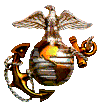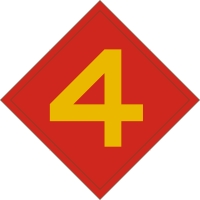


The Fourth Marine Division was formed during World War 2. The best description of the Fourth was presented in "The Fourth Marine Division in World War 2" Edited by Carl W. Proehl published by Infantry Journal Press in 1948.
According to Captain Proehl, the narrative was written by Master Technical Sergeant David Dempsey, former combat Correspondent with the Fourth Division and one of the five authors of The U.S. Marines on Iwo Jima. This book is available via reprints from the Battery Press.
The following is from The Fourth Marine Division in World War 2:
A division is merely a name until its component parts are joined and integrated into a single fighting unit. This process, for the Fourth, took more than a year. It began at Camp Lejeune, New River, North Carolina, where nearly all of the lower echelons were formed, and ended at Camp Pendleton, Oceanside, California, with the activation of the Division as a whole. During this period, separate battalions were combined to form regiments and regiments split to form new regiments; specialized units were welded together to make Special and Service Troops; and a Division Staff was organized.
To the Twenty-third marines goes the honor of being the oldest component unit of the Division. It was activated in July 1942, under Lieutenant Colonel William B. Onley, as a part of the Third Division. In September 1942, Colonel Louis R. Jones took command. On February 15, 1943, it was detached from the Third and five days later designated part of the Fourth. Colonel Jones, a baseball enthusiast, determined to make the Twenty-third not only a first-class fighting outfit but a ball-playing outfit as well, and its regimental team won a long string of victories.
For 15 cold days in January 1943, the Twenty-third conducted amphibious maneuvers in Chesapeake Bay - - a change, but hardly a relief from the long days of training in the North Carolina "boondocks" which all the units were undergoing during these formative months. On May 1 of the same year the Regiment was divided into two cadres, one of which was the nucleus of the Twenty-fifth Marines formed under Colonel Richard H. Schubert. Later that month the Fourth Service Battalion, the Ordinance Company, Division Headquarters Company, and the Fourth Signal Company were activated. On June 15, 1943, the Twentieth Marines, consisting of engineers and pioneers, was activated under Lieutenant Colonel Nelson K. Brown. During the same month the Fourteenth Marines, the Division's artillery regiment, was activated under Colonel Randall M. Victory.
All of these units were transferred, by ship and train, to Camp Joseph H. Pendleton during July and August 1943, and it was here that the Division was brought up to its full strength. Under the leadership of Colonel Franklin A. Hart, the Twenty-fourth Marines, which had been formed in March at Camp Pendleton by combining three separate reinforced battalions, was added. Two of these battalions had been formed at Camp Lejeune and were transferred to the West Coast where unit training was carried out upon organization of the Regiment. On August 16, 1943, the Division was formerly activated. The Fourth was now ready to undergo intensive training as a unit in preparation for combat.
The Division Staff was as follows:
Major General Harry Schmidt--------------------------------------Commanding General
Brigadier General James L. Underhill----------------------Asst. Division Commander
Colonel William W. Rogers-----------------------------------------------------Chief of Staff
Colonel Merton J. Batchelder------------------------------Assistant Chief of Staff, D-1
Major Gooderham L. McCormick-------------------------Assistant Chief of Staff, D-2
Colonel Walter W. Wensinger------------------------------Assistant Chief of Staff, D-3
Colonel William F. Brown------------------------------------Assistant Chief of Staff, D-4
Commander William C. Baty, Jr.-----------------------------------------Division Surgeon
Lt. Commander Otis P. Maddox-----------------------------------------Division Chaplain
The five regiments and other principal units of the Division at this time were commanded by the following officers:
Fourteenth Marines---------------Colonel Louis G. DeHaven
Twentieth Marines---------------Colonel Lucian W. Burnham
Twenty-Third Marines-----------------Colonel Louis R. Jones
Twenty-Fourth Marine---------------Colonel Franklin A. Hart
Twenty-Fifth Marines----------Colonel Samuel C. Cummings
Division Special Troops---------Colonel Emmett W. Skinner
Division Service Troops--------Colonel Richard H. Schubert
It was under this leadership that 17,831 men and officers (as of September 30, 1943) were welded into a hard-hitting fighting machine. In September 1942, training at Pendleton was begun on an intensive scale. The 132,000 acres of the former Santa Margarita Ranch with its hills, canyons, and semi-arid desert were ideal terrain for CPXs (command post exercises), field problems, hikes and maneuvers. Aliso Beach and San Clemente Island served as proving grounds for amphibious landings. In November, the Fourteenth Regiment moved in a body with its 75mm and 105mm howitzers to camp Dunlap, Niland, California, for extensive firing practice.
The three infantry regiments, reinforced with detachments of engineers, medical personnel, Joint Assault Signal men, and amphibian tractor units, boarded transports at San Diego and made a series of practice landings on Aslito Beach. Later the whole Division boarded ship and sailed to San Clemente Island, where, with Task Force 53 giving it live fire support, men stormed the beaches to "take" the island and then returned to their ships to do it again the following days. By now it was evident that the fourth was getting ready to move out. The objective, of course, was TOP SECRET.
A brief recital of the facts conveys but an impersonal outline of these three months of training. As real men were the personal experiences which these days and nights imprinted on their memories.
The experiences, for instance, of trying to stay warm at night in Las Pulgas Canyon. No matter how many blankets a person used, it was always cold. No doubt about it, when the sun went down, California was the coldest place this side of the North Pole.
And for the men of the twenty-fifth Marines and the Tank Battalion, inhabitants of the tent camps, this sub-arctic temperature was a nightly experience. But during the day, the famous California sun beaming down, Camp Pendleton was pleasant.
There are other things one will remember about Pendleton. The machine-gun range, bayonet practice, conditioning hikes, the moving-target range, pillbox assaults in Windmill canyon, night attacks near the Santa Margarita River, rubber-boat landings at the boat basin, combat swimming with the brutal words of the instructor: "STEP OFF!"
Everyone will remember the Post Exchange when it opened at 1030 and the rush for milkshakes..and the slopchute at night, where beer stimulated many an argument and cemented many a friendship..and the movies..and card games in the barracks..
And, of course, there were the liberties in "Dago" and "L.A." and points in between..the mad scramble for a bus, or a seat on the train, or a ride with a passing motorist..The Victory Inn and the Biltmore and the Hollywood Canteen. Sometimes it seemed that Pendleton was simply a place to stay between week ends in Los Angeles.
For you were living on borrowed time, for all you knew, and you wanted to live that time intensely. Every day was precious.
Out of these experiences-the good times as well as the bad-The Division grew into manhood. For a division is not just an aggregation of 17,000 men but an organic thing, with a personality and aspirations of its own. And all the thousand and one details of training and recreation combine to make that quality to which men referred when they talked about the "Fourth."
Early in January 1944, the Division boarded ship at San Diego. We were combat loaded! Everyone knew that this was to be the real thing. For many days supplies had moved off the docks and into holds...then the troops. The Division began a new and strange kind of life that it was to know too well before many months-life on a troop transport.
On January 6 and 7, LSDs and LSTs, carrying the Fourteenth Marines and amphibian tractor detachments, sailed out of the harbor. The remainder of the Division departed just after daybreak on the 13th. Men stood on the decks and watched San Diego grow fainter in the hazy distance. And then they turned and saw an illimitable sweep of ocean beyond which lay the enemy stronghold.
.
Powered by web statistics software.
HOME History 4th History 24th HQ Company Other Companies
In Memorium Parris Island Camp Pendleton Camp Maui Battle Photos